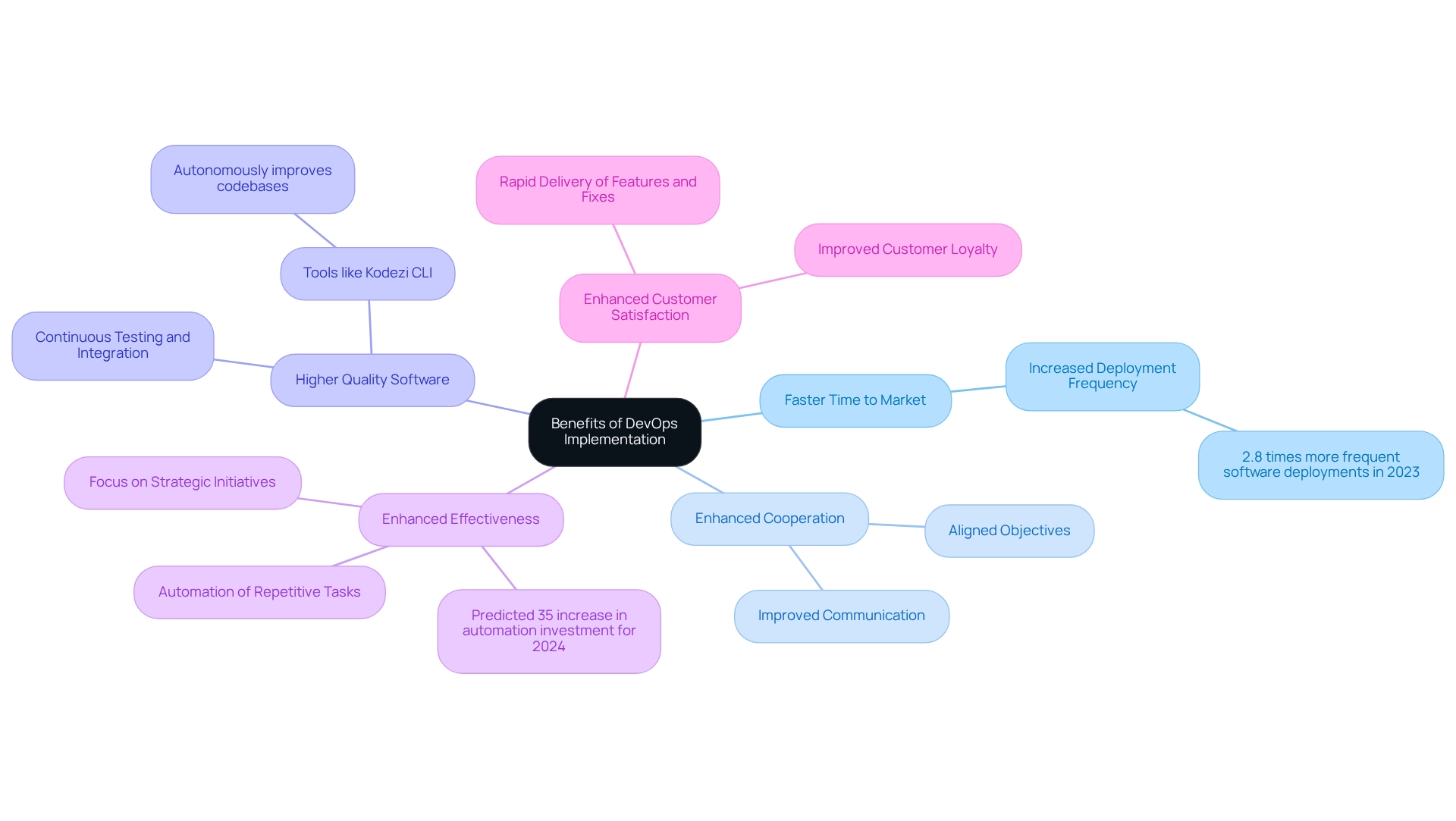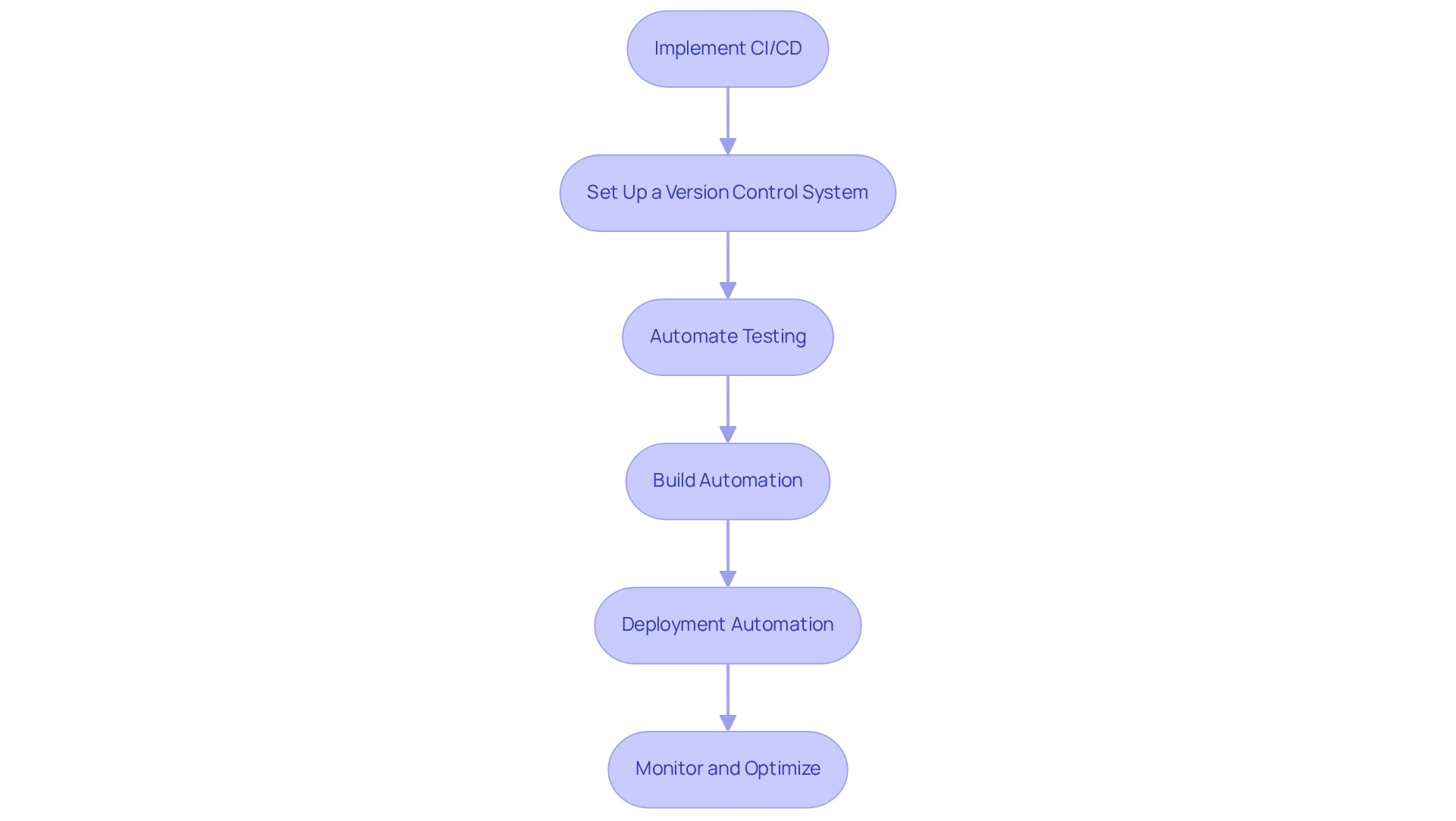Overview
The article highlights five essential DevOps systems that can significantly enhance team efficiency through collaboration, automation, continuous improvement, customer-centric action, and monitoring. How do these systems achieve this? By enhancing communication, streamlining workflows, and improving software quality, they facilitate faster delivery and increased customer satisfaction across various industries. Furthermore, these systems not only address common challenges faced by teams but also provide a framework for ongoing improvement and innovation.
Introduction
In the dynamic realm of software development, coding challenges present significant hurdles for developers. Many organizations grapple with inefficiencies that hinder their ability to deliver quality products. However, Kodezi emerges as a solution, effectively addressing these challenges with features designed to enhance productivity and streamline workflows. By automating repetitive tasks and providing intelligent code suggestions, Kodezi empowers developers to focus on what truly matters: crafting high-quality software.
Imagine being able to resolve coding issues swiftly and efficiently. Kodezi not only simplifies the debugging process but also enhances code quality through real-time feedback and collaborative tools. As developers leverage these capabilities, they experience notable improvements in their output and overall satisfaction.
Furthermore, the benefits of using Kodezi extend beyond mere productivity gains. By fostering a culture of collaboration and continuous improvement, teams can adapt more quickly to changing market demands. This adaptability is essential in today’s fast-paced digital landscape, where staying ahead of the competition is paramount.
Are you ready to elevate your coding experience? Explore the tools available on the Kodezi platform and discover how they can transform your development process. Embrace the future of software development with Kodezi, where efficiency and quality go hand in hand.
Define DevOps and Its Core Principles
This approach signifies a revolutionary method that combines software creation (Dev) and IT operations (Ops) to expedite the systems creation life cycle. This methodology is designed to deliver high-quality software more swiftly and reliably. The core principles of DevOps are essential for organizations aiming to enhance their operational efficiency.
- Collaboration: This principle highlights breaking down barriers between development and operations groups, promoting a culture of shared accountability. Effective collaboration is crucial, as it leads to improved communication and teamwork, which are vital for successful project outcomes.
- Automation: By leveraging tools and processes to automate repetitive tasks, organizations can minimize manual errors and significantly boost efficiency. Tools like Kodezi exemplify this principle by providing automated code debugging, allowing developers to instantly identify and fix codebase issues, address performance bottlenecks, and ensure security compliance. This not only streamlines workflows but also enhances code quality through performance optimization and code enhancement.
- Continuous Improvement: This principle underscores the importance of ongoing evaluation and enhancement of processes and products. Kodezi’s AI-driven automated builds and testing functionalities aid in this by autonomously examining bugs, enhancing code, and producing comments, allowing groups to quickly adjust to evolving requirements and uphold a competitive advantage in the market.
- Customer-Centric Action: DevOps emphasizes providing value to customers via swift feedback loops and iterative processes. By focusing on customer needs, teams can ensure that their software solutions are relevant and effective.
The adoption of these principles has been shown to enhance software development efficiency significantly. For example, industries like healthcare and energy are increasingly adopting collaborative development practices, showcasing its relevance across different sectors. As Prashant Pujara, CEO of MultiQoS, observes, "Incorporating proficient engineers in development and operations can significantly improve organizational capabilities." Furthermore, recent statistics indicate that organizations adopting agile methodologies are experiencing enhanced collaboration and productivity, reinforcing the significance of these core principles in today’s fast-paced development landscape.
Explore the Benefits of DevOps Implementation
Implementing DevOps offers a range of advantages that can significantly boost team efficiency.
- Faster Time to Market: Streamlining processes and automating workflows enables teams to deliver software updates more rapidly, allowing businesses to swiftly respond to market demands. Companies implementing modern development practices reported 2.8 times more frequent software deployments in 2023, underscoring the effectiveness of these methodologies. According to Jigar Agrawal, a Digital Growth Hacker, "companies that adopt development and operations practices pivot faster and perform better."
- Enhanced Cooperation: DevOps fosters a cooperative culture between the creators and operations groups, improving communication and aligning common objectives. This synergy is crucial for driving successful project outcomes.
- Higher Quality Software: Continuous testing and integration practices facilitate early identification and resolution of issues within the development cycle, resulting in fewer bugs and higher-quality releases. Tools like Kodezi CLI play a vital role here, autonomously improving codebases and fixing bugs before they reach production, ensuring that software integrity is maintained.
- Enhanced Effectiveness: Automation of repetitive tasks reduces manual effort, enabling groups to focus on strategic initiatives that foster innovation and growth. The Kodezi CLI improves programming output by allowing teams to auto-repair their codebases, which not only increases productivity but also enables teams to concentrate on higher-value tasks. The predicted 35% increase in investment for automation in 2024 highlights the critical role of DevSecOps in driving this efficiency. For those interested in getting started, Kodezi offers a 5-minute quickstart guide and a demo to showcase its capabilities.
- Enhanced Customer Satisfaction: Rapid delivery of features and fixes enables organizations to better meet customer needs and expectations, fostering improved satisfaction and loyalty. As DevOps systems in the development and operations landscape evolve, the future appears bright, with a growing number of organizations acknowledging their beneficial influence on performance and customer engagement.
The DevOps market is projected to grow at a CAGR of 16.1% through 2027, reflecting the increasing investment in automation and the critical role of DevSecOps in driving digital transformation. With an emphasis on expanding DevSecOps among groups, organizations are prepared to allow quicker, more secure software releases, as noted by 94% of CIOs. A mini-case study could further illustrate how these benefits translate into enhanced group efficiency in real-world scenarios.

Adopt Collaborative Practices and Tools
To enhance collaboration within DevOps systems, teams face various challenges that can impede progress. Implementing effective practices and tools can address these issues and significantly improve team dynamics and project outcomes.
- Regular Stand-Up Meetings: Conducting daily or weekly stand-up meetings fosters alignment on goals, progress, and challenges. Research suggests that efficient stand-up meetings can greatly enhance group dynamics and project results. In fact, 88% of organizations report increased trust levels between production and operations groups as a direct consequence.
- Cross-Functional Groups: Creating groups that incorporate members from both development and operations encourages collective ownership of projects. This approach has been shown to increase project success rates, as diverse perspectives lead to more innovative solutions. Insights from the case study titled "Contributors to High-Performing Groups" highlight that collaboration training and group goal-setting are significant factors in the success of high-performing groups.
- Collaboration Tools: Leveraging tools such as Slack, Microsoft Teams, or Jira streamlines communication and project management. These platforms keep group members informed and engaged, contributing to a more cohesive work environment.
- Version Control Systems: Implementing systems like Git allows for seamless collaboration on code changes, enhancing tracking and integration of contributions. This practice is essential for maintaining code quality and facilitating teamwork.
- Shared Documentation: Maintaining documentation in a centralized location ensures all group members have access to essential information, reducing misunderstandings and mistakes. A thoroughly documented procedure is crucial for sustaining high trust levels between production and operations groups, with 88% of companies indicating enhanced collaboration as a result.
By embracing these collaborative practices and tools, organizations can considerably enhance group productivity and foster successful results in their DevOps systems initiatives. Effective collaboration can lead to substantial cost savings, as exemplified by companies like Drift, which saved $2.4 million annually on AWS costs through enhanced teamwork. Explore how your team can implement these strategies to achieve similar results.
Implement Continuous Integration and Delivery (CI/CD)
Implementing Continuous Integration and Delivery (CI/CD) in devops systems can significantly enhance software production efficiency, addressing the common coding challenges developers face.
- Set Up a Version Control System: Start by utilizing a version control system like Git to manage code changes effectively. This not only monitors changes but also fosters collaboration among team members, minimizing conflicts and ensuring a more efficient workflow.
- Automate Testing: Next, integrate automated testing within the CI/CD pipeline to identify issues early in the development process. Research shows that automated testing can greatly improve the effectiveness of CI/CD, with organizations reporting a notable reduction in bugs and faster release cycles. In fact, those implementing CI/CD practices have experienced a 50% increase in their ability to experiment and innovate. Tools such as Jenkins and CircleCI are popular choices for automating this vital step.
- Build Automation: Implement build automation tools to compile code and execute tests automatically whenever changes are made. This guarantees that any integration problems are identified swiftly, enabling teams to maintain a high standard of code quality.
- Deployment Automation: Streamline the release process through deployment automation. Utilizing containerization tools like Kubernetes or Docker can facilitate smoother deployments. A notable case study on Trunk Based Development (TBD) illustrates how this agile approach enhances collaboration and reduces conflicts during deployment, allowing teams to roll back to stable versions quickly, thereby minimizing downtime.
- Monitor and Optimize: Finally, continuously monitor the CI/CD pipeline to identify bottlenecks and optimize processes. Regular updates and maintenance of test scripts are crucial to align them with evolving application functionalities, ensuring that the pipeline remains efficient and reliable. By highlighting the significance of preserving these scripts, organizations can promote the overall efficiency of their devops systems within the CI/CD process.
The uptake of CI/CD practices is growing, with organizations progressively acknowledging its value in enhancing communication between development and operations units. Furthermore, statistics reveal that organizations implementing CI/CD practices experience a 50% increase in their ability to experiment and innovate, emphasizing the importance of version control in this context. As we move through 2025, staying updated with the latest trends in CI/CD implementation will be essential for software teams aiming to boost efficiency and maintain a competitive edge.

Establish Monitoring and Continuous Feedback Mechanisms
In devops systems, ongoing success hinges on the establishment of robust monitoring and feedback mechanisms. To achieve this, teams can take several critical steps.
- Implement Monitoring Tools: Advanced tools like Prometheus and Grafana are vital for monitoring application performance and system health in real-time. These tools provide essential insights that help teams maintain optimal performance and swiftly address issues. Notably, statistics reveal that a significant majority of teams utilize effective monitoring tools, underscoring their importance in sustaining operational efficiency.
- Set Key Performance Indicators (KPIs): Defining specific KPIs is crucial for measuring the success of development and operations initiatives. Key metrics such as deployment frequency, lead time for changes, and change failure rates create a clear framework for evaluating team performance and identifying areas for improvement. As we approach 2025, the significance of KPIs in DevOps success remains paramount, serving as benchmarks for performance and guiding teams in their continuous improvement efforts.
- Gather User Feedback: Regularly collecting feedback from users is essential for gaining insights into their experiences. This practice not only highlights areas needing enhancement but also fosters a user-centric approach to development, ensuring that the final product aligns with user expectations.
- Conduct Retrospectives: Holding regular retrospectives allows teams to evaluate which strategies worked well and which did not. This practice cultivates a culture of ongoing enhancement, enabling teams to learn from past experiences and adjust their processes accordingly.
- Adapt and Evolve: Leveraging insights from monitoring and feedback enables informed decisions regarding process adjustments and tool enhancements. This adaptability is crucial in a rapidly evolving environment, where the ability to pivot can significantly impact team efficiency and project success.
Additionally, a notable skills gap exists within devops systems, particularly in areas such as security and cloud platforms, as highlighted in the case study titled 'Skills Gap in DevOps Teams.' This emphasizes the need for targeted training and upskilling initiatives. Furthermore, as noted by the Instatus group, "A high MTTR indicates your staff is struggling to keep up with customer demands, while a low MTTR signifies that you're able to swiftly address and resolve issues." By prioritizing effective monitoring and feedback mechanisms, teams can navigate these challenges and enhance their overall performance.

Conclusion
Embracing DevOps significantly transforms the software development landscape, fostering a collaborative environment that effectively bridges the gap between development and operations. The core principles of DevOps—collaboration, automation, continuous improvement, and customer-centric action—are essential for organizations aiming to enhance operational efficiency and adapt swiftly to market demands.
Implementing DevOps offers substantial benefits, including faster time to market, improved collaboration, higher quality software, increased efficiency, and enhanced customer satisfaction. These advantages are driving more organizations to invest in DevOps practices, with projections indicating substantial growth in the market. As companies adopt these methodologies, they not only streamline their processes but also position themselves to respond effectively to the ever-evolving digital landscape.
To fully realize the potential of DevOps, organizations must adopt collaborative practices, implement continuous integration and delivery (CI/CD), and establish robust monitoring and feedback mechanisms. By leveraging tools and strategies that promote real-time communication and continuous improvement, teams can ensure they remain agile and competitive. Ultimately, the successful integration of DevOps principles will lead to better project outcomes and sustained organizational success in the fast-paced world of software development.
Frequently Asked Questions
What is the DevOps approach?
The DevOps approach combines software creation (Dev) and IT operations (Ops) to expedite the systems creation life cycle, delivering high-quality software more swiftly and reliably.
What are the core principles of DevOps?
The core principles of DevOps include Collaboration, Automation, Continuous Improvement, and Customer-Centric Action, all aimed at enhancing operational efficiency.
How does collaboration play a role in DevOps?
Collaboration in DevOps breaks down barriers between development and operations groups, promoting a culture of shared accountability, which leads to improved communication and teamwork essential for successful project outcomes.
What is the significance of automation in DevOps?
Automation minimizes manual errors and boosts efficiency by leveraging tools to automate repetitive tasks, such as code debugging with tools like Kodezi, which enhance code quality and streamline workflows.
What does continuous improvement entail in the context of DevOps?
Continuous improvement involves ongoing evaluation and enhancement of processes and products, facilitated by tools like Kodezi that autonomously examine bugs and enhance code, helping teams adapt to changing requirements.
How does DevOps ensure customer-centric action?
DevOps emphasizes providing value to customers through swift feedback loops and iterative processes, ensuring that software solutions meet customer needs effectively.
What advantages does implementing DevOps offer?
Implementing DevOps offers advantages such as faster time to market, enhanced cooperation, higher quality software, improved effectiveness through automation, and increased customer satisfaction.
How does DevOps contribute to faster time to market?
By streamlining processes and automating workflows, DevOps enables teams to deliver software updates more rapidly, allowing businesses to respond quickly to market demands.
In what ways does DevOps enhance software quality?
Continuous testing and integration practices in DevOps facilitate early identification and resolution of issues, resulting in fewer bugs and higher-quality software releases.
What is the projected growth of the DevOps market?
The DevOps market is projected to grow at a CAGR of 16.1% through 2027, reflecting increasing investment in automation and the importance of DevSecOps in driving digital transformation.




